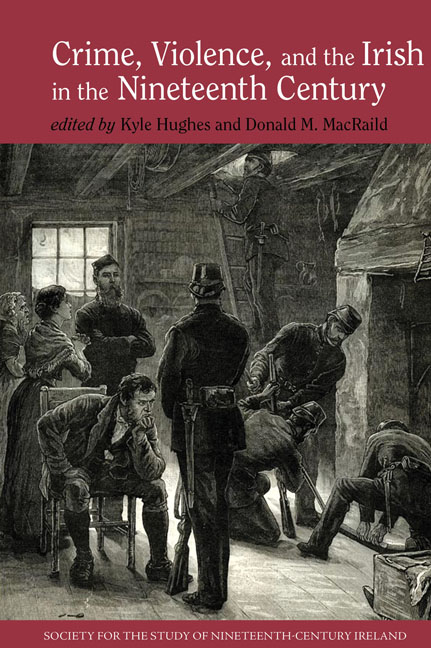Book contents
- Frontmatter
- Contents
- List of Illustrations
- List of Contributors
- Introduction: Crime, Violence, and the Irish in the Nineteenth Century; Themes and Perspectives
- Section 1 ‘Secret Societies’ and Collective Violence
- 1 Whiteboys and Ribbonmen: What's in a Name?
- 2 The Law of Captain Rock
- 3 ‘Night Marauders’ and ‘Deluded Wretches’: Public Discourses on Ribbonism in Pre-Famine Ireland
- 4 Organised Labour in Limerick City, 1819–1821: Violence and the Struggle for Legitimacy
- Section 2 The Law and its Responses
- Section 3 Sectarianism and Violence
- Section 4 Manifestations of Crime and Violence
- Index
1 - Whiteboys and Ribbonmen: What's in a Name?
from Section 1 - ‘Secret Societies’ and Collective Violence
- Frontmatter
- Contents
- List of Illustrations
- List of Contributors
- Introduction: Crime, Violence, and the Irish in the Nineteenth Century; Themes and Perspectives
- Section 1 ‘Secret Societies’ and Collective Violence
- 1 Whiteboys and Ribbonmen: What's in a Name?
- 2 The Law of Captain Rock
- 3 ‘Night Marauders’ and ‘Deluded Wretches’: Public Discourses on Ribbonism in Pre-Famine Ireland
- 4 Organised Labour in Limerick City, 1819–1821: Violence and the Struggle for Legitimacy
- Section 2 The Law and its Responses
- Section 3 Sectarianism and Violence
- Section 4 Manifestations of Crime and Violence
- Index
Summary
The modern historiography of pre-Famine collective action in Ireland has been characterised by a willingness to move beyond protonationalist narratives of oppressed Gaelic peasants and rapacious Saxon landlords. Since J.S. D onnelly's now-venerable and enduringly admirable accounts of the major eighteenth-century Munster movements, first published during the 1970s, a number of historians have explored apparently similar mobilisations during the period between the rebellion of 1798 and the great Famine, immersing themselves in what David Fitzpatrick described as the incomparable richness and detail of the reports submitted to Dublin Castle. These explorations added enormously to historians’ understanding of Irish ‘social’ crime during the period, and broke decisively out of the bunker of nationalist historiography.
Yet, curiously, the historiography has failed to displace a model of collective action that identifies such mobilisation as the activity of secret societies. This chapter suggests that the blanket use of the secret societies model is outmoded and that it is only applicable, in any meaningful way, to Ribbon societies, rather than the more widespread and endemic pre-Famine rural popular protest. In making this case, it is necessary to consider what distinguished Ribbon activity from the widespread ‘redresser’ activity of the period, and to consider more profitable ways of seeing collective action in the pre-Famine Irish countryside. Indeed, this chapter suggests that the labelling of such action in early nineteenth-century Ireland as the activity of ‘secret societies’ tends to connect those conflicts with political master-narratives of sectarianism and nationalism in much the same way as many contemporary commentators did.
The many parliamentary enquiries into the disturbed state of Ireland during the early nineteenth century were concerned, above all, with political stability. Conditioned by the experience and memory of 1798, as well as the urgent question of Catholic relief, the various committees of enquiry summoned a range of witnesses who raised some preoccupations of their own but rarely stepped outside the paradigms that informed the questions of the politicians.
- Type
- Chapter
- Information
- Crime, Violence and the Irish in the Nineteenth Century , pp. 21 - 37Publisher: Liverpool University PressPrint publication year: 2017

